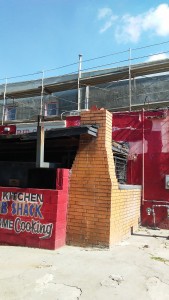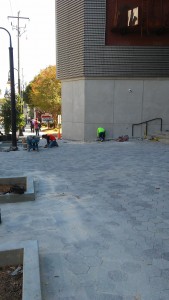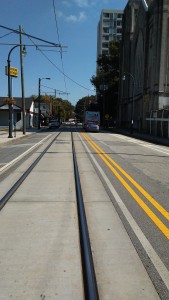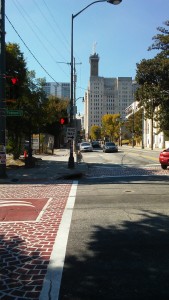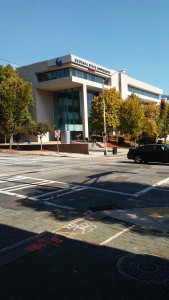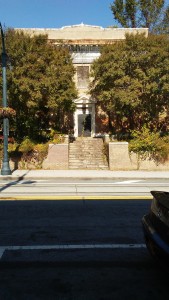Tall, beautiful, majestic, all words that come to mind when you first lay eyes on this architectural marvel. The buildings beautiful exterior eludes from its position along what would seem to be the more “underdeveloped” part of Auburn Avenue. When the building appears on the horizon, it gives off a sense of detachment. The sense only grows stronger as you move towards it, eventually seeing a clear and distinct perimeter surrounding the vicinity. The scenery changes, trees become more abundant, the smell of flowers permeate the air, as it does away with the previous smell of decay.
Tag Archives: Political
Building Renovation
Nearly deserted, walking towards Thelma’s Kitchen and its immediate vicinity feels equivalent to walking alongside an alleyway. Located only a couple feet away from the highway, Thelma’s Kitchen is a relic of the past, and its existence seems to almost self-perpetuate its period. Its bright red brick walls stand out amongst its surroundings, making it the center of attention to any passerby. Right next to the shack, a building is undergoing renovations. The metal bars that strut upwards offers a unique view as pedestrians see for themselves the process of change occurring on the street of Sweet Auburn.
Street Renovations
Sounds of metal on metal echo out along the Avenue as workers lay down new tiles in place of old. Caution tape and working cones surround sections of the sidewalks as more extensive renovations are underway. The streets here, towards the upper end of Auburn Avenue, are under much more care than what you would see walking forward.
Street Disparity
Walking from Georgia State’s T deck to the intersection of its Honors College is an entirely different experience than the proceeding half of Auburn Avenue. Walking towards the Honors College is a breath of city life, the wind hits you, carrying with it a wide variety of smells coming from the numerous restaurants around, coupled with the smell of gasoline, accompanied by honking and sirens, and the sight of other pedestrians, it is the embodiment of city life. Walking the other stretch of the street, you will notice pretty quickly the difference in experience. The sounds change, the increasing sights of homelessness increase, cars, buildings, everything takes an almost 180-degree turn.
Building Disparity
The picture above juxtaposes two buildings, one being Georgia State’s Honors College, while the other, a run-down, abandoned building. The two are found side by side. The Honors College is adorned with modernism, its sharp edges, its cleanliness, the use of glass for natural light; everything about the building exudes an air that befits contemporary society. The building right next to it, however, is the epitome of difference; everything the Honors College is, it is not. Covered in what appears to be kudzu and a variety of other vegetation, the building, both in sight and smell, reek of decay.
BED Political
I stuck with Auburn Avenue (Sweet Auburn) once again as I found myself infatuated with both it’s cultural, as well as its political history. Located just a walk away from Down Town Atlanta, Sweet Auburn was and still is, the center for civil rights. The iconicity of the avenue goes unquestioned, as even to this day, movements such as “Black Lives Matter” take to the Avenue as their roots. Walking along the street you will see a variety of sights, ranging from modern buildings, to run down, abandoned, business. Sometimes, the two are situated right next to one another. The disparity between visuals bombards the entirety of the walk and will open the door to which a peek can be seen of the streets intricateness; albeit, one filled with ups and downs. The differing visuals and cues of the street hit you like a hurricane as you walk through what seems like the annals of time, experiencing both past and present. The sights and audio of the street all radiate black culture, which comes to no surprise as the street was once known as the most thriving black American business district in the U.S. By far a hollow husk of its former self, it continues to live on.
The street, despite its degradation, survives to this day mostly in part by the influences of politics. Auburn Avenue has a long history of political influence; it would not be false to say, that their present iconicity comes from extensive policies dealing with segregation way back when. Moving forward, civil rights leaders such as John Dobbs, the “unofficial mayor” of Auburn Avenue, worked closely with Mayor Hartsfield to provide to the street. His grandson, Maynard Jackson, who eventually became the mayor himself, also poured his efforts to the revitalization of the street. Auburn Avenue became what it was through politics. It is what it is today through the same politics. The Street is constantly changing, reshaping itself and redefining its presence, all due to the influence of politics. Changes show itself as you walk further along the road, it won’t take long before you chance upon areas where renovations are being done to what used to be old, run down buildings. These repairs represent the underlying politics that surrounds the Avenue as the city wishes to undergo an effort of revitalization. When walking around these areas, the sound, as well as the look, if only a minuscule amount, starts to change. Political decisions have shaped the built environment of the street for decades and will continue to do so in the coming times.

